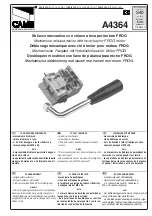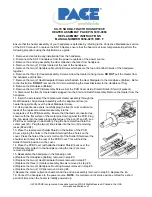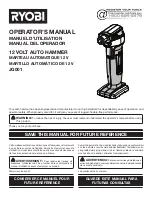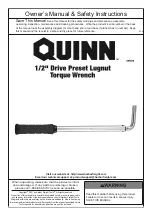
12
Vertical Band Saw
10.4 TOP GUIDE ADJUSTMENT
Always position top guide to within 1/8” of the top sur-
face of workpiece. This minimizes exposure of operator’s
hands to the saw blade.
10.5 CHANGING SAW BLADES
1.
Disconnect saw from power source.
2.
Move upper blade guide to its highest position and
lock in place.
3.
Open both wheel doors. Turn tension adjustment
knob counterclockwise to loosen tension on
blade.
4.
Remove blade guard from column. Remove blade
from both wheels and maneuver it around protective
shield on upper blade guide. Use gloves when
handling
blades.
5.
Install new blade by maneuvering around blade
shield on upper blade guide.
6.
Place it between the fi ngers of both blade guides
and onto both wheels. Position next to both wheel
fl anges. Make sure teeth point down toward table.
NOTE: If teeth will not point downward regardless
of blade orientation, the blade is inside-out. Twist
blade outside-in and reinstall.
7.
Verify that blade rests against ball bearing (Figure
10), not behind it.
8.
Reinstall blade guard on column.
9.
Tension blade by turning tension knob. Rotate
wheel by hand and make sure blade is properly
seated in blade guides. Blade guides will have
to be adjusted if the replacement blade is a different
type and width.
10. Turn on saw and check blade tracking. Adjust track-
ing if necessary.
10.6 WORK LAMP BULB
The work lamp uses a standard medium-base 60 watt
bulb (not provided).
11.0 BLADE SELECTION
Proper blade selection is just as important to band saw
operation as is blade speed and material feed. Proper
blade selection will impact blade life, straightness of cut,
cut fi nish, and effi ciency of operation. Excessive blade
breakage, stripping of teeth, and waviness of cut are some
of the results of improper blade selection.
Blades are classifi ed by material composition, tooth
shape, tooth pitch, tooth set, gage of the band material,
and kerf of the set (width of cut).
11.1 MATERIAL COMPOSITION
Carbon Steel
– low cost, for use with non-ferrous materi-
als, wood, and plastics.
High Speed Steel
– resists heat generated by dry cutting.
Used for ferrous metals.
Alloy Steel
– tough and wear resistant, cuts faster with
longer blade life. Used on hard materials. More expensive
than carbon or high speed steel.
Carbide Tipped
– for cutting unusual materials such as
uranium, titanium, or beryllium.
Fig. 10
Fig. 9
H
I
G
F
Содержание EVBS-26
Страница 25: ...25 EVBS 26 BREAKDOWN ASSEMBLY EVBS 26...
Страница 36: ...36 Vertical Band Saw NOTES...













































